This site is supported by our readers. We may earn a commission, at no cost to you, if you purchase through links.
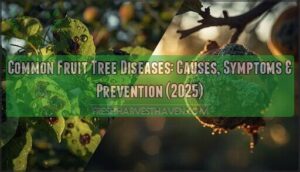 Your fruit trees looked perfect last month. Now their leaves have brown spots and the fruit is rotting on the branch. This shift happens fast when disease strikes an orchard.
Your fruit trees looked perfect last month. Now their leaves have brown spots and the fruit is rotting on the branch. This shift happens fast when disease strikes an orchard.
Most fruit tree owners miss the early warning signs until the damage spreads. Fungal spores travel on the wind. Bacteria enter through pruning cuts. Viruses move from tree to tree through insects.
Each pathogen has its own pattern of attack. Learning to spot these patterns protects your trees before minor infections become orchard-wide problems.
Table Of Contents
- Key Takeaways
- Common Fruit Tree Diseases and Their Causes
- Recognizing Symptoms of Tree Diseases
- Managing and Treating Fruit Tree Diseases
- Preventing Fruit Tree Diseases Effectively
- Fruit Tree Pests and Their Impact on Health
- Frequently Asked Questions (FAQs)
- How to identify diseases in fruit trees?
- What does fungus on fruit trees look like?
- How do you treat fruit trees for disease?
- How to identify tree disease?
- How fast do fruit tree diseases typically spread?
- When is the best time to inspect trees?
- Do organic sprays work against serious tree infections?
- Should infected trees be removed from the orchard?
- How do weather conditions affect disease spread?
- Can diseased trees recover without treatment?
- Conclusion
Key Takeaways
- Fruit tree diseases fall into three main categories—fungal infections spread through spores in wet weather, bacterial diseases move rapidly through rain and tools, and viral diseases have no cure once established, making prevention and resistant varieties your strongest defense.
- Early detection saves trees by catching symptoms like leaf spots, fruit rot, wilting branches, and bacterial ooze before diseases spread orchard-wide, with weekly inspections and proper tool sterilization stopping most pathogen transmission.
- Effective disease management combines cultural practices like pruning infected wood and removing debris, targeted chemical treatments such as fungicides or antibiotics when needed, and integrated pest management that balances biological controls with economic thresholds.
- Prevention through disease-resistant rootstocks and varieties, proper watering and nutrition, clean pruning practices, and regular monitoring delivers better long-term results than reactive treatment while reducing chemical costs and protecting tree health.
Common Fruit Tree Diseases and Their Causes
Fruit trees face threats from several types of disease-causing organisms. Understanding what causes these conditions helps you protect your orchard and catch problems early.
Here’s what you need to know about the primary disease types threatening your fruit trees.
Fungal Diseases (Apple Scab, Brown Rot, Coral Spot)
Fungal diseases sneak into your orchard through wounds and damp conditions, turning healthy fruit trees into struggling hosts for apple scab, brown rot, and coral spot.
Apple scab creates velvet-textured blotches on leaves and fruit. Brown rot enters through damaged skin and spreads quickly across ripening fruit. Coral spot targets dead wood with raised pink spots.
These fungi reproduce through spore dispersal during wet weather, making fungal control and disease prevention essential for your trees.
Bacterial Diseases (Fireblight, Bacterial Canker)
Bacterial infections move faster than fungi and can kill entire branches in days, with fireblight and bacterial canker topping the threat list for apples and stone fruits.
Fireblight causes blossoms to wilt and produces white ooze from infected bark. Bacterial canker creates sunken lesions on branches and trunks.
Both diseases spread through rain and pruning tools, making orchard hygiene and canker prevention critical for bacterial resistance and stopping disease spread.
Viral and Phytoplasma Diseases
Viruses and phytoplasmas don’t move as fast as bacteria, but they’re harder to treat since no cure exists once a tree gets infected. These pathogens spread through grafting risks and phytoplasma vectors like insects, making disease identification and resistance breeding your best defense against viral diseases.
Prevention strategies include:
- Inspect nursery stock before planting to catch plant diseases early
- Sterilize grafting tools to prevent virus transmission between fruit trees
- Remove infected trees immediately to stop disease prevention failures
Choosing resistant varieties protects your orchard better than any treatment can.
Biotic Vs. Abiotic Disease Factors
To manage orchard disease effectively, you need to distinguish between living pathogens and environmental stressors.
Fungal infections and bacterial threats are biotic—they come from organisms you can fight with targeted prevention methods and resistant varieties.
Abiotic problems stem from soil pH, temperature swings, and moisture extremes that affect yield impact differently. Nonliving agents like these can be a primary cause of such issues.
Tracking tools that monitor both types of problems show why you need a combined approach—your fruit trees face multiple threats at once, and managing them separately just doesn’t cut it.
Recognizing Symptoms of Tree Diseases
Catching a disease early can make the difference between saving your tree and losing it. You’ll need to know what to look for on leaves, fruit, bark, and blossoms.
Learn what to watch for so you can act fast.
Leaf Spots, Blotches, and Mould
When you spot discolored patches on your tree’s leaves, you’re looking at one of the most common warning signs that disease has taken hold. Leaf spots often show up as khaki green blotches with a velvet texture—that’s apple scab at work. Grey mould appears as fuzzy brown patches on leaves and stems.
Identifying leaf spots early helps you stop fungal diseases before they spread throughout your orchard.
Fruit Rot and Damage Signs
Brown rot doesn’t wait for an invitation—it shows up as soft, spreading decay that can swallow your harvest before you notice the first brown spot. This fungal disease enters through wounds and spreads fast.
You’ll see brown patches expanding across fruit surfaces. The rot often develops fuzzy spore masses.
Identifying rot types early protects your yield and prevents economic losses that can wipe out an entire season’s work.
Wilting, Cankers, and Oozing
Fireblight strikes with alarming speed, turning healthy blossoms into blackened, wilted tissue that looks scorched by flame. You’ll spot white or amber ooze seeping from infected bark—a telltale sign of bacterial canker.
Canker identification starts with sunken, cracked lesions on branches and trunks. Wilt causes stem from bacterial invasion blocking water flow.
Treatment options include pruning infected limbs and applying copper-based sprays. Disease progression accelerates in warm, wet conditions, so early tree disease diagnosis saves your orchard.
Differentiating Disease From Pest Damage
You can’t always tell disease from pest damage at first glance—symptom overlap tricks even experienced growers. Visual inspection catches about 78% of cases correctly, but lab tests boost diagnostic accuracy to 94%.
Look for clues: fungal fruit damage symptoms show dark, corky patches, while insect pests leave crescent marks or tunnels. Fruit trees are especially susceptible to bacterial diseases, like fire blight, which can cause significant harm.
Proper tree disease diagnosis through integrated management cuts unnecessary sprays by 35%, protecting both your wallet and the environment while keeping common fruit tree pests and plant diseases in check.
Managing and Treating Fruit Tree Diseases
When disease strikes your fruit trees, quick action matters. What you do next hinges on the culprit behind the problem and its severity.
You can fight disease with sanitation, treatments, natural remedies, and prevention tactics.
Cultural Sanitation and Pruning
You can’t win the war against fruit tree diseases without good sanitation practices and smart pruning techniques. Start by removing infected twigs and branches as soon as you spot them. Sterilize your tools between cuts to avoid spreading disease.
Clean up fallen leaves and fruit from around your trees. This debris removal stops pathogens from overwintering. Proper pruning also improves air circulation through the canopy, which helps prevent common fruit tree diseases.
Fungicide and Antibiotic Applications
Chemical treatments work when cultural methods fall short. Modern fungicides need just one to four applications per season compared to older products that required ten or more. Efficacy control is impressive—fungicides dropped grape black rot from 95% to 1% and peach brown rot losses from 75% to 1%.
- Resistance development demands smart application patterns like rotating FRAC groups and tank-mixing products
- Streptomycin sprays reduce blossom blight to under 4% in susceptible cultivars
- Regulatory aspects now limit rates and frequency to protect both crop protection strategies and environmental health
Economic impact is significant—fungicide use adds roughly $13 billion annually to U.S. farm income through better disease management of both fungal and bacterial threats.
Natural and Organic Disease Remedies
Organic growers rely on copper sprays, sulfur dusts, and biological controls that work with nature instead of against it. Neem oil targets fungal diseases, while baking soda sprays shift leaf pH to discourage infection. Companion planting strengthens tree health through beneficial microbial activity.
| Remedy | Best For |
|---|---|
| Copper sprays | Bacterial diseases, fireblight |
| Neem oil | Fungal diseases, disease prevention |
| Probiotics | Fruit tree health, root protection |
Integrated Pest and Disease Management (IPM)
IPM combines multiple strategies into one flexible approach that’s suited to your orchard’s unique challenges throughout the season. You’ll set monitoring thresholds to track pest and disease activity, then apply biological controls like beneficial insects before reaching economic thresholds that justify reduced-risk pesticides.
This layered system prioritizes tree health and disease prevention while keeping orchard pest management costs down and fruit tree health strong.
Preventing Fruit Tree Diseases Effectively
The best defense against disease? Start early. Pick resistant varieties and give your trees what they need to thrive—healthy soil, proper spacing, and consistent care.
What follows is all about prevention: building strength from the roots up.
Disease-Resistant Varieties and Rootstocks
When choosing your fruit trees, disease-resistant varieties and rootstocks offer powerful protection against common pathogens. Apple breeding programs have developed over 88 cultivars with varying resistance profiles—Liberty apples show immunity to fire blight and high scab resistance, while scab-resistant varieties like Belmac reduce chemical needs.
Rootstock effectiveness matters too: MP-29 resists Armillaria root rot in peaches. These integrated strategies deliver serious economic benefits, with growers saving millions annually on pesticides while boosting yields.
Tree Care, Watering, and Nutrition
Healthy trees fight off diseases better than stressed ones, so proper watering and balanced nutrition form your frontline defense.
Here are some key ways to keep your fruit trees healthy:
- Water deeply but infrequently – Soil health depends on consistent moisture without waterlogging roots.
- Apply mulch around the base – Mulching benefits include temperature regulation and moisture retention.
- Test soil before fertilizing – Balanced nutrition starts with understanding what your tree actually needs.
- Time fertilization carefully – Feed in early spring when trees actively grow, supporting vigorous tree health throughout the season.
Pruning Hygiene and Orchard Sanitation
Clean tools prevent the spread of pathogens from branch to branch, making pruning hygiene as important as the cuts themselves. Sterilize your tools between cuts with rubbing alcohol or bleach solution for effective tool sterilization and plant disease prevention.
Remove all pruned debris from the orchard immediately since fallen branches harbor fungal diseases that threaten fruit production techniques.
Apply wound treatment to large cuts and avoid composting practices that include diseased material, which compromises orchard management and tree fruit disease management efforts.
Monitoring and Early Detection Techniques
Regular inspections catch symptoms before they spiral out of control. Remote sensing and AI diagnostics now detect plant disease identification issues up to two weeks early, helping with tree diagnosis and identifying fruit tree problems.
Mobile monitoring apps boost field response times by 25%, while HTS sequencing uncovers hidden viruses old tests miss.
These advances improve plant disease prevention and deliver strong economic impact through faster fruit damage symptoms detection.
Fruit Tree Pests and Their Impact on Health
Pests can weaken your fruit trees just as much as diseases can. Aphids, scale insects, mites, and even larger animals like rabbits and pigeons all pose threats to tree health and fruit production.
Know your enemy—and how to stop them—and you’ll keep your harvest safe and your trees thriving.
Common Pests (Aphids, Scale, Mites, Animals)
Your fruit trees face threats from more than just diseases—insects and animals can weaken your trees just as quickly if left unchecked. Aphids suck sap from new growth and cause stunted leaves. Brown scale insects drain nutrients from plums and peaches. Glasshouse red spider mites create fine webbing and cause leaf drop on stone fruits. Squirrels strip bark and steal fruit.
Understanding pest lifecycles helps you time your integrated control methods effectively.
Pest Identification and Damage Symptoms
Aphid damage and spider mite webbing can look similar until you know what to look for—and catching the right culprit early makes all the difference. Watch for these telltale signs:
- Aphids leave sticky honeydew on leaves and fruit that attracts ants and causes sooty mold secondary infections
- Scale insects create yellow leaf spots and premature fruit drop from their persistent feeding signs
- Spider mites produce fine webbing on leaf undersides and cause bronze-colored stippling before leaves fall
- Bird and animal damage shows torn bark, missing buds, and partially eaten fruit damage symptoms across branches
- Frass identification helps you spot borers—look for sawdust-like droppings near trunk holes indicating serious insect infestations
Check your trees weekly during the growing season. Pest-induced deformities like curled leaves or misshapen fruit often signal garden pests that need immediate pest control attention.
Pest Control Methods (Organic and Chemical)
Once you’ve identified the culprit, it’s time to pick your weapon—and the good news is you don’t always need harsh chemicals to win this battle. Organic pesticides like neem oil and insecticidal soap knock out aphids and spider mites without harming beneficial insects.
For serious insect infestations, systemic insecticides travel through the tree’s vascular system to target garden pests from the inside.
IPM strategies blend both approaches—releasing ladybugs while keeping chemical application as your backup plan for dealing with fruit tree pests effectively.
Supporting Tree Health for Pest Resistance
Your fruit trees are like athletes—the healthier they are going into the season, the better they’ll handle whatever disease or pest pressure comes their way.
Tree vigor starts with soil health and balanced nutrition. Feed your trees properly and keep beneficial microbes thriving in the root zone.
Healthy soil builds natural defenses that support disease resistance and overall tree health. This foundation is your best tool for preventing fruit tree diseases and managing tree fruit problems before they start.
Frequently Asked Questions (FAQs)
How to identify diseases in fruit trees?
Think of tree diagnosis like piecing together a mystery—you’re hunting for clues. Scan the leaves for spots, off colors, or branches that seem to be wilting.
Check fruit for rot or blemishes. Early disease signs help you catch common fruit tree diseases before they spread and threaten tree health.
What does fungus on fruit trees look like?
Fungal infections on fruit trees show up as velvet-textured blotches, furry grey-brown mould patches, coral pink spots on dead wood, or brown spreading rot in fruit.
Visual diagnosis helps identify specific fungal diseases affecting your trees.
How do you treat fruit trees for disease?
Once disease hits, time matters. Spot the signs early and match your response to what you’re dealing with—there’s no one-size-fits-all here.
Prune infected parts, apply fungicides for fungal diseases, and use antibiotics for bacterial disease control.
Effective disease management combines treatment timing with long-term solutions like sanitation and monitoring.
How to identify tree disease?
Look for early disease signs like leaf spots, wilting branches, or unusual oozing.
Environmental factors and disease progression help determine if it’s fungal diseases, bacterial infections, or viral diseases.
Use diagnostic tools or seek professional assistance for accurate plant pathology assessment.
How fast do fruit tree diseases typically spread?
How fast a disease spreads depends heavily on environmental factors—humidity and temperature play major roles.
Fungal disease management is critical since Spore Dispersal can happen in hours under wet conditions. Bacterial infections and Viral diseases spread slower, requiring Disease Vectors or wounds.
Incubation Periods vary widely across Crop diseases.
When is the best time to inspect trees?
You should inspect your fruit trees at four key times each year. Check them during the dormancy period before spring growth starts.
Examine blossoms carefully for early disease signs. Monitor throughout the growing season after weather events like heavy rain or hail.
Do organic sprays work against serious tree infections?
Organic sprays can manage mild to moderate fungal disease infections when applied at the right timing. However, they often fall short against severe infections, where conventional fungicide sprays provide stronger long-term disease control.
For disease-resistant fruit trees, organic options support overall disease management without increasing resistance development risk.
Should infected trees be removed from the orchard?
Not always. Around 30% of orchard losses stem from removing salvageable trees too quickly. You can often save infected fruit trees through targeted pruning and disease management strategies.
Cut away diseased branches, improve orchard sanitation, and monitor for disease spread. Partial removal beats wholesale replacement when fungal disease hasn’t invaded the root system.
Assess each tree’s long-term impact on fruit production before making the call.
How do weather conditions affect disease spread?
Weather plays a major role in disease spread. Warm, humid conditions favor fungal infections and oomycete diseases.
Rainfall effects include spreading spores and creating moisture on leaves. Wind dispersal carries pathogens between trees.
Seasonal variation means spring and fall bring higher disease management challenges.
Can diseased trees recover without treatment?
Some trees can bounce back on their own if the disease is mild and environmental stress factors are low. Natural tree defenses and tree species resilience play key roles.
However, severe fungal infections and viral diseases often require disease management to protect long-term tree health.
Conclusion
Think of your orchard as a living shield. Each inspection you make strengthens it. Each clean cut with sterilized tools blocks an entry point.
Recognizing common fruit tree diseases before they spread turns reactive panic into proactive care. Your trees won’t fight these battles alone if you stay one step ahead.
Check your leaves weekly. Remove infected debris immediately. Choose resistant varieties when you plant. Disease management isn’t about being flawless—it’s about vigilance that compounds into healthier harvests year after year.

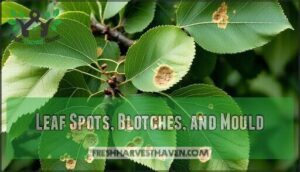
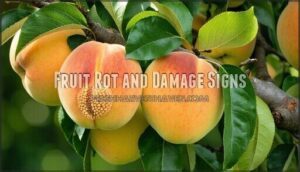
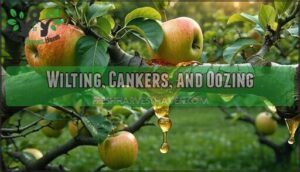
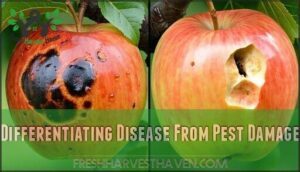
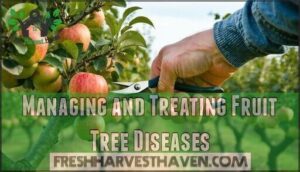
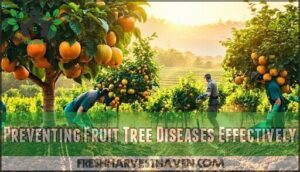
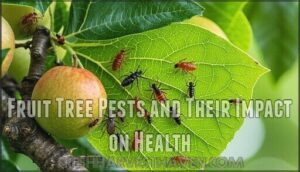
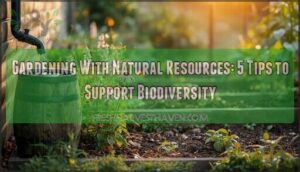


Yimosuk Julious
April 30, 2025 at 05:27 AM
I concur with your summarize notes and I will love get more feeds from you guys